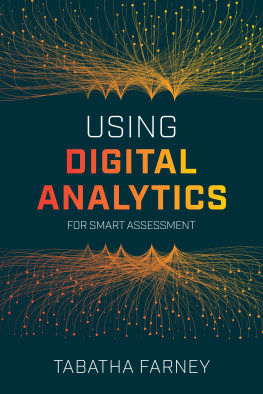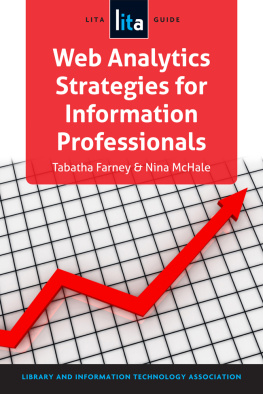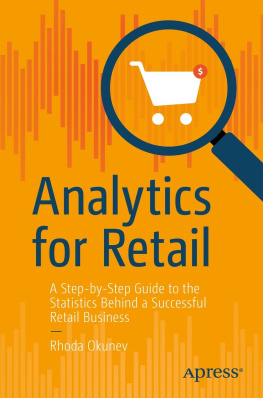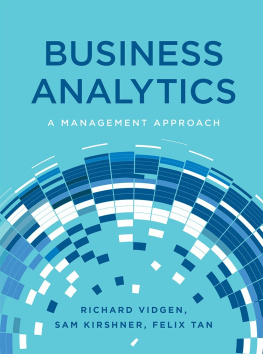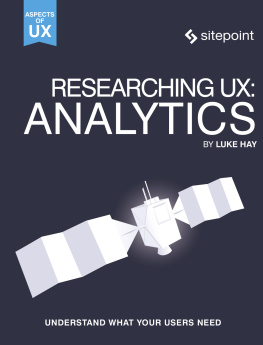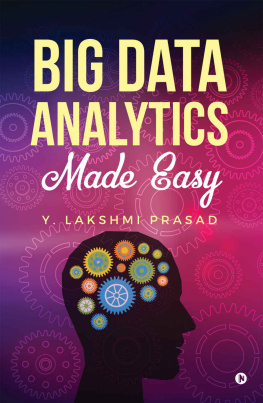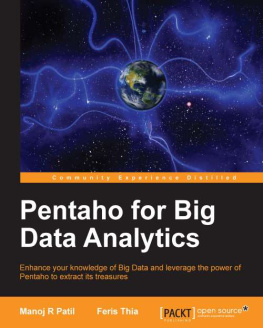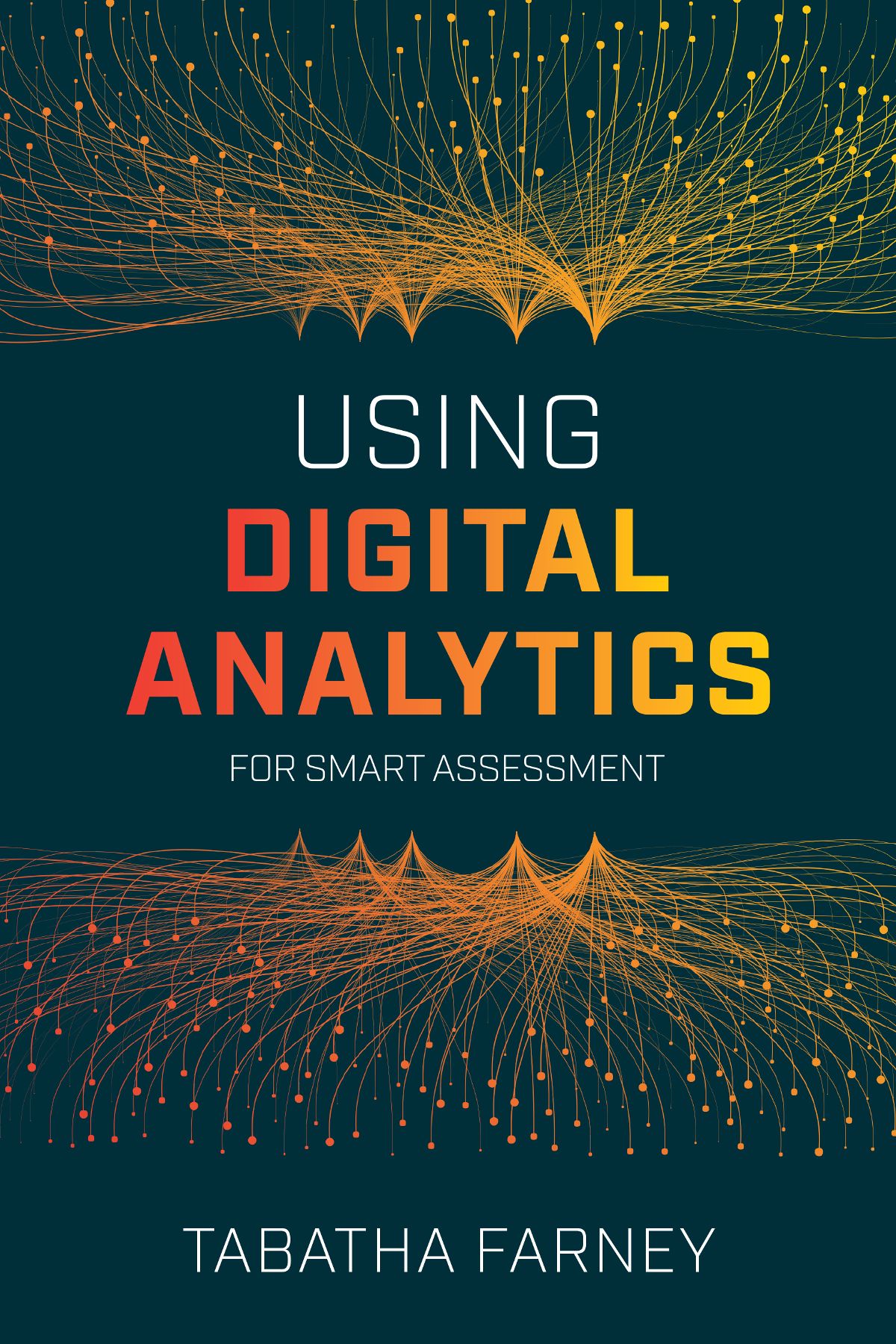
ALA Editions purchases fund advocacy, awareness, and accreditation programs for library professionals worldwide.
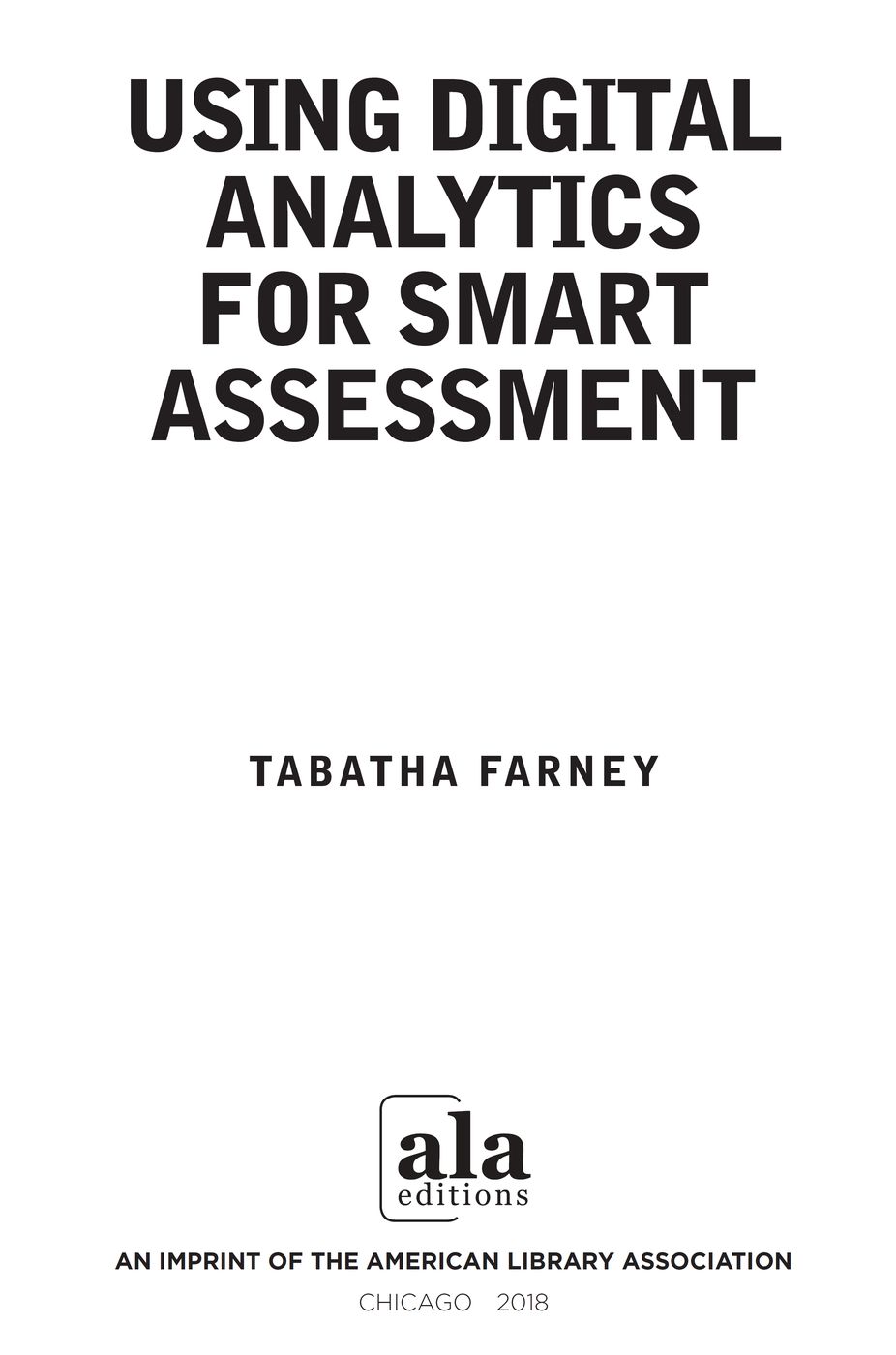
TABATHA FARNEY is the director of web services and emerging technologies for the Kraemer Family Library at the University of Colorado Colorado Springs. She is an avid analytics enthusiast with more than ten years of experience. Tabatha coauthored the 2013 LITA Guide Web Analytics Strategies for Information Professionals and has written two Library Technology Reports on configuring Google Analytics and Google Tag Manager for library-specific websites and search tools. She has presented her analytics research at national conferences and served as an analytics consultant for various library organizations. She is a cofounder and current cochair of LITAs Altmetrics and Digital Analytics Interest Group.
2018 by the American Library Association
Extensive effort has gone into ensuring the reliability of the information in this book; however, the publisher makes no warranty, express or implied, with respect to the material contained herein.
ISBNs
978-0-8389-1598-1 (paper)
978-0-8389-1686-5 (PDF)
978-0-8389-1685-8 (ePub)
978-0-8389-1687-2 (Kindle)
Library of Congress Cataloging-in-Publication Data
Names: Farney, Tabatha, author.
Title: Using digital analytics for smart assessment / Tabatha Farney.
Description: First edition. | Chicago : ALA Editions, 2018. | Includes bibliographical references and index.
Identifiers: LCCN 2017024325| ISBN 9780838915981 (paperback : alk. paper) | ISBN 978-0-8389-1685-8 (ePub) | ISBN 9780838916865 (PDF) | ISBN 9780838916872 (Kindle)
Subjects: LCSH: LibrariesEvaluationStatistical methods. | Library administrationDecision makingStatistical methods. | Library usersStatisticsData processing. | Library Web sitesUse studies. | Online library catalogsUse studies. | Electronic information resourcesUse studies. | Web usage mining. | Data visualization. | Library statisticsUnited StatesCase studies.
Classification: LCC Z678.85 .F38 2018 | DDC 025.042072/7dc23 LC record available at https://lccn.loc.gov/2017024325
I dedicate this book to Leif Farney, who has patiently listened to my crazy analytics ideas for more than ten years.
Contents
PART I
THE DIGITAL ANALYTICS PROCESS
TABATHA FARNEY
Tools and Data Points You Should Know
Digital Analytics and Data Analysis Tools
How Helpful Is Your Online Content?
PART II
EXPANDING THE DIGITAL ANALYTICS PROCESS
The University of Michigan Librarys Experience with Privacy and Library Data
LAURIE ALEXANDER, DOREEN R. BRADLEY, AND KENNETH J. VARNUM
MICHAEL D. DORAN
LAURA COSTELLO AND HEATH MARTIN
Revealing Dynamic Reference Services through Digital Analytics
MARISSA C. BALL AND MELISSA DEL CASTILLO
JOEL TONYAN
LIBRARIES ROUTINELY COLLECT MASSIVE AMOUNTS of data and sometimes even analyze that data to drive the decision-making process. For example, web analytics is the practice of analyzing website use data to make improvements to a website. Web analytics is well-known to libraries, and there is much published research on using website use data to improve website usability and the overall user experience. So what is digital analytics? As the name suggests, digital analytics focuses on the digital data describing the use and users of online content. For libraries, digital data includes, but is not limited to, use data from various library websites, electronic resources, online collections, and even social media.
This type of data is often included in various library analytics projects, so why focus on digital analytics when it is a subset to other analytics? I argue that digital analytics is a useful addition for any library because digital data is usually incorporated into these larger library analytics programs, but it is often simplified into basic units of measurement that miss useful insights into understanding library users and their actions. By focusing on digital analytics, our attention turns to digital data and how it is collected. In turn, this improves the data collection process and generates better data that enhances the data-driven decision-making process. Even if your library doesnt invest in a library analytics program, digital analytics is an easy entry into systematically collecting library-related digital data because it often relies on data already being collectedyou just need to clean up the data and combine the different data sources as necessary.
Regardless of your job title, accessing and analyzing digital data is essential for assessing library services in the online and offline world. This book is written for anyone interested in analytics. It presents technical advice on configuring various data tools for system or website administrators but also includes useful reports and policy information for library administrators. Online content creators and library marketers can use the digital analytics projects mentioned in this book as models to develop their own digital analytics projects. Digital data has so many potential uses!
To keep this book manageable, I focus on introducing digital analytics specifically for libraries and describe several digital analytics projects to demonstrate its process. This book guides libraries to think holistically about their online presenceafter all, the library website is just one component of all the online content a library maintains or manages. Tracking all meaningful use data for a librarys online presence is a challenge, but a worthwhile one, as you can use that data for many different assessment projects. While this book is designed to introduce you to these digital data points, it will not make you a subject matter expert in every data point or data tracking tool used in your library. That takes time and direct experience working with those tools.
Additionally, this book does not advocate one analytics tool over another one. It is important to know your data tool options, but since tools are constantly changing, I focus instead on digital analytics practices and concepts that remain consistent. All that said, I still describe the current data tools. I also provide specific step-by-step instructions for configuring certain digital analytics features in Google Analytics because it is widely utilized, but often libraries do not take advantage of all of its useful features. This book demonstrates different data tools, but it is up to you to decide which data points and data tools are most meaningful for your library.
ORGANIZATION
This book is divided into two sections: the first section describes the digital analytics process while the second section features contributed case studies to expand on issues I briefly mention, such as user privacy, or present additional digital analytics projects occurring in other libraries.
, Understanding Digital Analytics, introduces the concept of digital analytics and defines a librarys online presence. It discusses the basic elements of the digital analytics process and shares the potential challenges and benefits to adopting digital analytics in your library.
Digital analytics is a two-step process, starting with collecting the necessary digital data and then analyzing it in a robust data analysis tool. Understanding useful digital data points, data tracking tools, and data analysis tools greatly enhances your digital analytics practice. , Analyzing Digital Data: Digital Analytics and Data Analysis Tools, presents digital analytics and traditional data analysis/visualization tools to help analyze all that digital data you collect. Since many libraries use Google Analytics, I demonstrate two of its useful digital analytics features, custom metrics and dimensions and the Measurement Protocol, in this chapter as well.
Next page
